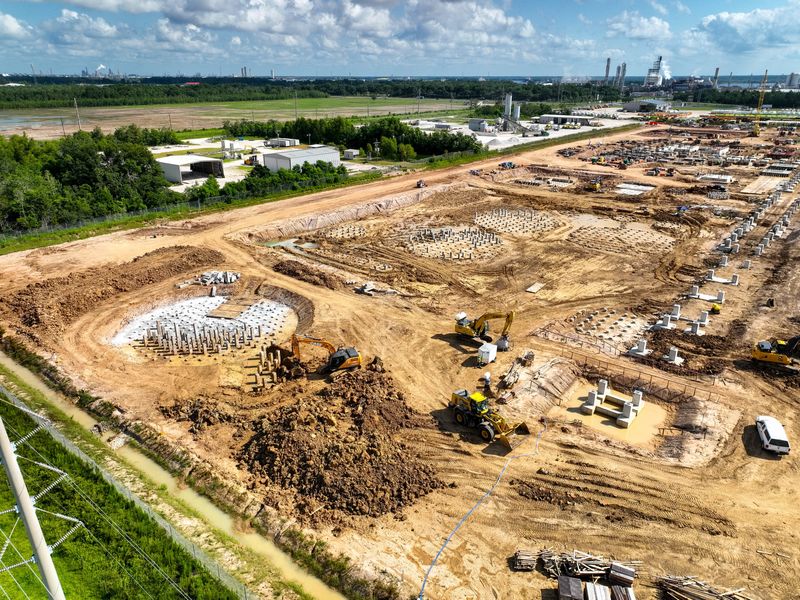By Rod Nickel and Victoria Klesty
(Reuters) - Without a single sales contract in hand, Dutch fertilizer company OCI is building a $1 billion plant in Texas to produce ammonia with low greenhouse gas emissions, a gamble requiring heavy government subsidies, new markets and a contingency plan.
OCI's plant would be the world's first new commercial facility to capture and sequester 95% of the emissions produced from making ammonia. The hydrogen and nitrogen compound is mostly used as fertilizer.
But the lure for OCI and others of making ammonia with a smaller carbon footprint is a business with potential beyond the farm. That includes production of fuel for coal-burning Asian utilities and for ships, both uncertain but potentially lucrative commercial possibilities.
"'Are you crazy?' is the question, and I think it's a good question," OCI CEO Ahmed El-Hoshy told Reuters, when asked why his company is betting on producing so-called "blue ammonia."
Producing blue ammonia costs up to $119 per metric ton more than the conventional method, but U.S. Inflation Reduction Act (IRA) subsidies worth roughly $145 per ton cover the difference, said CRU Group fertilizers analyst Alexander Derricott.
To make the economics of his Beaumont, Texas plant work, El-Hoshy said he also needs Asian utilities paying premium prices to justify the capital cost.
The $430 billion IRA aims to cut carbon emissions across the U.S. economy, mostly through technologies that are uneconomic without subsidies.
But even with U.S. support, blue ammonia economics hinge on further government incentives. This time the incentives are expected from Japan and South Korea for utilities to produce electricity with less emissions, using coal and 20% ammonia. That is the percentage utilities consider technologically feasible for now without causing emissions of another pollutant, nitrous oxide, to increase.
If utility premiums don't emerge, OCI plans to use its Texas blue ammonia to make fertilizer in The Netherlands, where the company has under-utilized its plants due to high natural gas prices. It can also sell it to industrial buyers looking to decarbonize, or sell it in the United States, El-Hoshy said.
OCI's Texas plant, to start production in 2025, will produce 1.1 million metric tons annually.
Global ammonia demand looks to climb 10% by 2030 from 2021 to 203 million tons annually, according to TD Cowen and Yara data. Demand then soars to 294 million tons by 2040 and 470 million by 2050, according to the data.
Others are tiptoeing into the sector. Fertilizer rivals CF Industries (NYSE:CF), Yara and Nutrien (NYSE:NTR) are mulling building their own U.S. Gulf Coast plants, but are at least a year from breaking ground.
Japanese utility JERA has signed non-binding agreements to buy low-emissions ammonia from CF and Yara, with commercial production slated around 2027. Mitsui is a partner with CF on its Gulf project and Mitsubishi has signed a non-binding offtake agreement with Nutrien.
CF has committed $285 million to capture emissions at two U.S. ammonia plants and says it has firm buyers for all the blue ammonia it would produce from the possible new plant with Mitsui.
Investors and analysts are not yet convinced. Yara last month postponed an initial public offering of its clean ammonia business, citing low market valuation.
"Probably the biggest unknown is if the end markets will really be there," said Stephan Werner, senior portfolio manager for Germany's DWS Group.
If new markets do develop, however, "for sure these companies will be worth far more than they are today," Werner said.
Japan and South Korea are expected in the next year to create incentives for utilities to reduce emissions, unlocking premium prices for blue ammonia, El-Hoshy said.
"The question will be, how sufficient will the incentives be?"
TECHNICAL QUESTIONS
Technology incorporating 20% ammonia in co-generating electricity with coal is still in development. Special burners are required for power units as ammonia burns more slowly than natural gas. Such plants would still spew double the air pollution of plants that use gas and steam, according to energy analysis firm TransitionZero.
Co-firing ammonia could result in extended life for coal plants, rather than phasing them out, said Katrine Petersen, senior policy advisor at environmental group E3G.
"Ammonia co-firing is unlikely to ever become a widely deployed approach to power-sector decarbonisation," Petersen said.
JERA said in a statement that it will begin demonstrating co-firing with 20% ammonia this fiscal year.
"The question is, when will this hit, not will this hit,'" said CF Chief Financial Officer Chris Bohn.
SHIPPING DEMAND
Member countries of the International Maritime Organization on Friday adopted a revised strategy for shipping that sets a net zero emissions target "by or around 2050."
The first ammonia-fueled ships are due to be piloted next year, but the toxic gas, also comes with higher safety issues and higher costs, two big impediments, said Oystein Kalleklev, CEO of ship-owning companies Flex (NASDAQ:FLEX) LNG and Avance Gas. Kalleklev nevertheless ordered ships this spring that can burn ammonia as he weighs future options for his fleet.
Routes for ammonia-fueled ships along so-called "green corridors" can likely become workable with subsidies from national authorities, said Harald Fotland, CEO of Odfjell, a tanker company involved in an ammonia pilot project.

However, using ammonia for ocean-going ships looks unprofitable for the foreseeable future and the fuel first needs to become readily available globally, he said.
"We go to hundreds of ports," Fotland said. "So to get (ship owners) to go for an ammonia solution, that I think is very far in the future on deep sea."